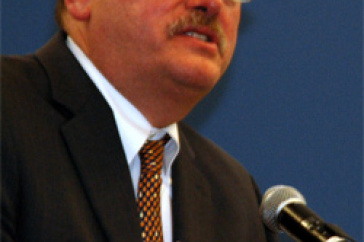New Study Finds New England Is Losing Forest Cover

UNH College of Engineering and Physical Sciences Alumni Society 2010 Distinguished Alum Robert Phillips, of Hampton Falls says, "At UNH I was taught the fundamental joy of learning as well as how to apply that learning to solve problems." Credit: Carolyn Kirkpatrick
DURHAM, N.H. - New England forests are at a turning point. A new study released today by the Harvard Forest and co-authored by University of New Hampshire Provost John Aber reports that, following almost 200 years of natural reforestation, forest cover is declining in all six New England states. The authors of the "Wildlands and Woodlands" report call for conserving 70 percent of New England as forestland, a target that they say is critical to protecting vital natural benefits that would be costly, and in some cases impossible, to replace.
"Forests are crucial to the economic, environmental, aesthetic and cultural well-being of New Hampshire. We can ensure the continuation of a mostly forested landscape without sacrificing economic growth by preserving 63 percent of the landscape as working woodlands," says Aber, who is also a professor of natural resources at UNH. "Many state-based nonprofit organizations have been working for this goal, and will continue to do so. This is and will be a locally based, citizen-based program."
Aber, whose research concerns sustainable ecosystem management, contributed working farmland preservation recommendations to the report. For his contribution, he drew on his work studying nutrient and energy balances at UNH's Organic Dairy Research Farm, as well as his long associations with Harvard Forest and the Society for the Preservation of New Hampshire Forests.
The report was authored by 20 scholars in forest science, policy, and finance from across New England. It examines forest trends and promotes strategies for permanently retaining 70 percent of the New England landscape in forest over the next 50 years. The vision would triple the amount of conserved land in New England while still leaving ample room for future development. It calls for conserving most of the landscape (63 percent) as working woodlands owned and managed by private landowners, and protecting a smaller portion (7 percent) as wildland reserves.
"We've been given a second chance to determine the future of the region's forests. This report calls attention to the pressing need to couple New England's existing conservation capacity and shared land ethic with a vision for the next century in which forests remain an integral part of our livelihoods," says David Foster, lead author of the report and director of the Harvard Forest. Foster points to clean water, climate protection, and renewable wood supply as examples of the forest's many benefits to society.
The report cites development and changing forest ownership patterns as two major drivers of forest loss and instability in the region. It points to the need to support the interests of the many private landowners who have stewarded the majority of the region's forests for decades and seek to keep their forestland intact. Rob Lilieholm, co-author and professor of forest policy at the University of Maine, Orono, points out that a vision for conserving forests at this scale holds many benefits for the people of the region. "I think it's clear that we all stand to gain from the 'Wildlands and Woodlands' vision. Landowners will have more options in how they choose to manage their lands. The region's forest products sector, vital to the economic health of countless rural communities, will benefit from a secure source of timber. And residents and visitors alike will be able to enjoy these working landscapes and the wide range of services they provide now and in the future."
The "Wildlands and Woodlands" report outlines a suite of collaborative, voluntary approaches to accelerate conservation. James Levitt, co-author of the report and director of the Harvard Forest Program on Conservation Innovation, notes, "New England has, for nearly four centuries, been a leader in conservation. With the groundswell of regional interest in 'Wildlands and Woodlands' specifically and in landscape-scale conservation generally, New Englanders are well-positioned to provide leadership in the practice of innovative conservation, this time in the 21st century."
The report, "Wildlands and Woodlands: A Vision for the New England Landscape," was produced by the Harvard Forest of Harvard University. It will be released to the public this evening at the Harvard Kennedy School of Government, featuring comments by Theodore Roosevelt IV and David Foster. For event details visit: www.wildlandsandwoodlands.org/invite. Those interested in learning more about the report are invited to attend the Wildlands and Woodlands conference on June 4 in Concord, hosted by the New England Forestry Foundation. Visit http://www.newenglandforestry.org/newwconf.html for more.
A copy of the report is available at www.wildlandsandwoodlands.org.
The Harvard Forest, founded in 1907 and located 70 miles west of Boston, is Harvard University's center for research and education in forestry and ecology. Its 3,500 acre property is one of the oldest and most intensively studied research forests in North America. For more information visit: http://harvardforest.fas.harvard.edu/.
The University of New Hampshire, founded in 1866, is a world-class public research university with the feel of a New England liberal arts college. A land, sea, and space-grant university, UNH is the state's flagship public institution, enrolling 12,200 undergraduate and 2,200 graduate students.
-30-
Reporters and editors: John Aber is available at mailto:john.aber@unh.edu"
Latest News
-
July 2, 2024
-
June 18, 2024
-
June 18, 2024
-
May 17, 2024
-
May 14, 2024

















































